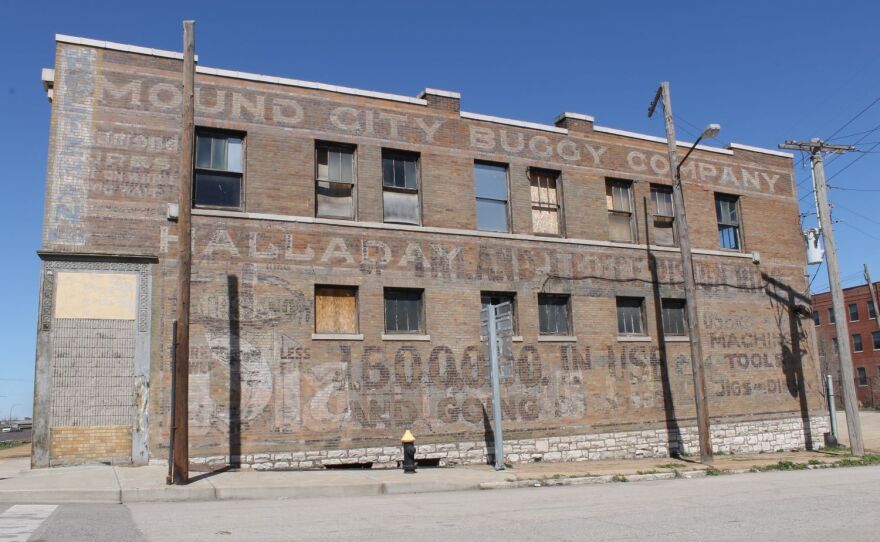Plans for a new St. Louis football stadium seem to be moving ahead. Just last week, NFL commissioner Roger Goodell called the stretch of riverfront near the Edward Jones Dome a “perfect” location for the new sports venue.
But it is also the site of an ancient Native American city — and that is raising concerns.
_
The site proposed for the new football stadium is just a few blocks north of Laclede’s Landing. But other than vacant lots, abandoned industrial buildings and a handful of businesses, there is not a lot there.
Missouri Governor Jay Nixon, who is championing the stadium project, has called the neighborhood “blighted.”
But about 900 years ago, it would have been a thriving Native American town, centered around a vast plaza and about two dozen massive earthen mounds — a lot like its more well-known neighbor across the river at Cahokia Mounds in Collinsville.
There is still plenty we do not know about the Native American people who lived on this side of the Mississippi in that prehistoric “Mound City.” Most of the mounds were destroyed by the mid-1800s. And, unlike in Illinois, there has not been much archeology done here to find out what might be left underground.

But Joe Harl with the Archaeological Research Center of St. Louis believes that if we were to start digging, we would certainly find Native American artifacts dating back to the time of Cahokia and possibly ancient burial sites as well as human remains.
Harl would like to see the developers of the new football stadium pay for some archaeological research before starting construction. But he says on private land, with private funding, they won’t have to. “Only if they are using federal funding or permits, are they required to do archaeology,” Harl said.
The current stadium proposal doesn’t include any federal funding or permits. But the plan does rely on state bonds to cover about half of the project’s almost $1 billion price tag. Harl said that would be fine if this were Arkansas, Iowa and Illinois, where it would trigger an archaeological dig. “Unfortunately in Missouri it doesn’t,” Harl said.
Harl said he is not against the stadium being built. He just wants whatever is left of the Cahokian-era civilization to be salvaged before the earth movers destroy it.

But for some Native Americans, including the Osage in Oklahoma, any more disturbance of the former mounds — even for research — would be a desecration. On that point, Everett Waller, the chairman of the Osage Minerals Council, is adamant. “Those are our burial mounds you’re talking about,” Waller said. “This isn’t some subject you’re going to pull out of a drawer.”
The Osage consider themselves to be descendants of the mound-builders. Andrea Hunter, who directs the tribe’s historic preservation office, said that means that to the Osage, the site of the St. Louis mounds is sacred, even if nothing is left of the mounds, above ground. “These features no longer exist, but the importance of them still exists for us,” Hunter said. “And the fact that they were destroyed doesn’t lessen that importance to us.”

Dave Peacock heads up the task force appointed by Gov. Nixon that put together the stadium proposal. He declined to be interviewed for this story, but the task force provided the following brief statement: “We’re aware of the concerns and will be mindful of them as we continue to work through the planning process.”
Nixon’s office and the National Football League did not respond to requests for comment. But speaking to reporters at the planned site of the new stadium in February, the governor made his position clear.
“If we do nothing, then we’re not an NFL city,” Nixon said. “If we do nothing, then $10 million of taxes a year is gone. If we do nothing, then people will stand right here 10 years from now, and that will look exactly like it looks like, right there.”
Osage official Everett Waller could not disagree more. “Sometimes it’s not a football that matters,” Waller said. “It’s not the all-American dollar that matters. [The proposed stadium site] needs to be looked at as a sacred site that it really is.”
Andrea Hunter plans to brief the Osage Nation’s top cultural officials about the stadium at their next meeting on April 10. She says it will be up to them to advise the tribe’s leadership about what to do next.
Follow Véronique LaCapra on Twitter: @KWMUScience









